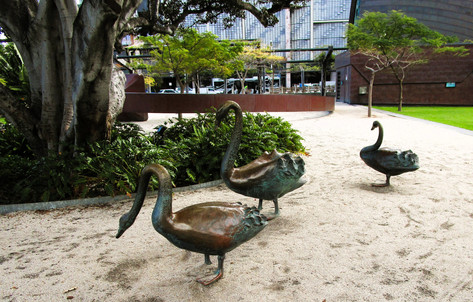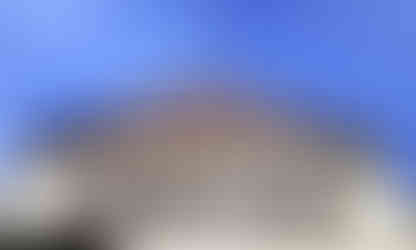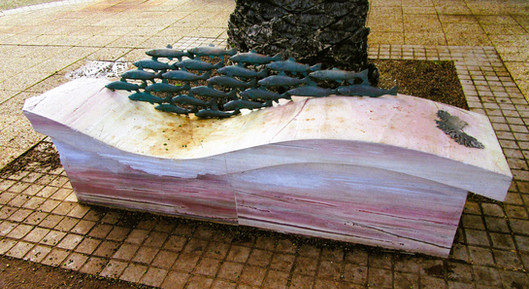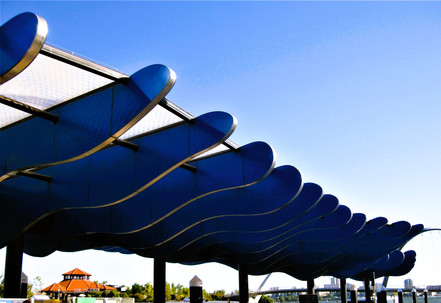Elizabeth Quay Public Art Walk - Perth City
- Out and About
- Feb 14, 2021
- 6 min read
Updated: May 25, 2025

Elizabeth Quay has so much to offer in the way of dining and entertainment options and it is also a wonderful place for a wander around with family, friends or visitors. Within a short space there are 10 pieces of public art, some of which are very noticeable, others are tucked away and are a little harder to find.
An Art Trail Map and background information can be downloaded at: https://elizabethquay.com.au/eq/see-do/attraction/public-art-walk
We started our Art Trail at Spanda, located at The Landing and overlooking Elizabeth Quay inlet. Spanda's 29m tall design represents ripples and links the Swan River with the land and sky, also referencing the ripples of water design reflected in the pavements. Spanda is the world's largest free standing carbon fibre structure. This Elizabeth Quay landmark can be seen from afar but you can also interact with the sculpture up close by walking around and through it.

From Spanda wander past the Ritz Carlton Hotel. Look up and admire the stunning architecture of this building and it's sister building the Towers. As you pass through the space between these buildings look down and see if you can find the line representing where the original jetty was.

Emerging on the other side you will see the magnificent Bell Tower. Did you know that the design of the Towers ensured that the bell's acoustics are not muffled by the building?

Cross over the Bell Tower Courtyard to Barrack Square Gardens where you will find Signature Ring. In 1999, as part of a community project to support the opening of the Bell Tower and celebrate the millennium, school students from around Western Australia were invited to sign their names into history as part of the Sign In 2000 project. More than 200,000 student's signatures were etched into 2,375 tiles laid in a pathway at the foreground of the Bell Tower. Unfortunately the tiles were damaged or removed during the construction of Elizabeth Quay however fortunately all the signatures had been digitally recorded and could be reimaged as etchings on the copper plates of the Signature Ring. Signatures are entered under the name of the school but they are quite small and difficult to read.

The Signature Ring is built with the same copper panels as the Bell Tower and it will oxidise and change colour over time. The Signature Ring reflects a headphone-shaped design featuring over 400 kilometres of fibre optics that illuminate interactive panels which make people walking past one end of the ring appear as a shadow at the other end, representing the passage of time from 2000 to the present (best observed at night).
Here you can also find the Bronze Swans. Can you decipher the words engraved along their neck and feathers? Wander a little further along The Esplanade to see the West Australian Rowing Club and some fishy artworks nearby before passing The Lucky Shag to check out their murals.
From the Bell Tower walk around to the inlet side of the Towers Development to see one of the Blade Walls installations. The other Blade Wall is on the opposite side of the inlet. These artworks are designed to be updated every 18 months providing new opportunities for emerging Whadjuk artists to display their work.
Did you spot the massive gold nugget? This is part of The Heart of Gold, an interactive virtual gold adventure through Perth using augmented reality games, fun widgets, timeless photos, and exclusive audio and video stories via the free Heart of Gold Australia app.
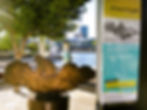
Retrace your steps to The Island and turn to walk around Florence Hummerston Cottage towards Spanda on the opposite bank. Down the winding pathway you will find Bessie Mable Rischbieth. Bessie (1874-1967) was active in the preservation of the Swan River and is best known for taking stand against its reclamation to build the Narrows Bridge. Her statue here at Elizabeth Quay alongside a black swan is very fitting as Elizabeth Quay reconnects the city with the waterfront, encouraging the people of Perth to enjoy the river’s natural beauty.


The river side of The Island has a nature playground for the kids including a 3 storey climbing tower, sand and water play with locks and sluices. At the back of the playground is The Black Swan mural which tells the story of how the black swans, native to Western Australia, came to be. " The swans, originally white, were attacked by eagles tearing out all their feathers after the swans visited the eagles lagoon. Crows flew to the rescue covering the swans with their own black feathers, transforming the swan's coat from white to black and their bloodstained red beaks forever."
Crossing the bridge over the inlet to Williams Landing you will see First Contact, a shiny 5m tall cast aluminium artwork depicting the arrival of European settlers to Perth. The local Noongar people believed that the boats arriving on their shore were their past ancestors returning from the sea.

Here you will also find a Perth sign - great for those Insta shots! Along the construction site is an extensive colourful mural painted by Melski depicting native flora and fauna. For a longer walk you can extend along the Swan River foreshore wandering through David Carr Memorial Park and looping back through John Oldham Park.
Following the inlet shoreline you will come across the second Blade Wall. At the ferry terminal you may see EDGE, a giant artwork which runs the length of the inlet, best seen at night when it illuminates the water. EDGE can be programmed to reflect the changing weather conditions, creating a spectacular night time or special event light show.
Four Winds atop the ferry terminal canopy explores the idea of air - imagining wind travelling across Elizabeth Quay from all directions, in motion, amidst, around and over the billowing, blue sky coloured canopy. The shapes change form as you move underneath them and could be puffs of smoke or floating clouds, sails or whatever you see in your imagination.

As you skirt the BHP Billiton Water Park observe Pinjah, the mosaic artwork that makes up the base of the water playground. The artwork represents the Dreaming story of the creation of the Milky Way. Pinjah, the Whadjuk word for tadpole, depicts water winding its way through the playground with the smaller blue circles representing Hyde Park Lake and Lake Monger - the only two remaining lakes that are left in the greater Perth area. The black circle is representative of the ongoing presence of the Noongar people of South Western Australia and the red circle symbolises the blood of the people, in the past, the present and the future.

BHP Water Park can be an artwork in itself as the interactive water feature uses jets and lighting to create fun and exciting water choreography. During the day you can enjoy splashing in the fountains but at night you can enjoy the wonderful kaleidoscope of coloured jets. Note the Water Park may be closed temporarily so check before arriving on the facebook page.
On the wall of the food outlet you will find Horizontal Geometries where mosaic colours represent the riverbed. On the upper levels of the building the river is reflected through horizontal changes of light seen at different times of day and year. Small boxes tell the story of the history and development of Elizabeth Quay and hold artefacts found during construction.


If you are able to access Lot 4 (often used for private or public ticketed events) wander through the Interpretive Garden reflecting a local Dreamtime Story: the boys, the moon and the sealions.
Continue by wandering past the traditional venetian Elizabeth Quay Carousel back to your starting point at the Landing. Maybe grab an icecream at Gusto Gelato and admire Abundance where the printed glass reflects the diamonds mined in WA. Other public artworks can also be found at 1 The Esplanade.
Or if you are heading back to Elizabeth Quay Station stop to admire Oushi Zokei, Mobilus in Space carved from Japanese pink granite by Keizo Ushio in 2009 and the wall mural inside the station on the western end.
Many of these artworks are best seen under illumination at night so explore Elizabeth Quay during the day and also at night to enjoy both experiences.

To read more blogs go to:
I love wandering along trails, both marked and unmarked, and sharing my discoveries with my Out and About FNC community. If you enjoy reading my blogs please consider a small donation which will be used towards the costs of keeping the website up to date and relevant.

In the spirit of reconciliation Out and About- Family Nature Connection acknowledges the traditional owners of the Wadjak boodjar (Perth land) and their connections to land, sea and community. We pay our respect to their elders past and present and emerging and extend that respect to all Aboriginal and Torres Strait Islander peoples today.

